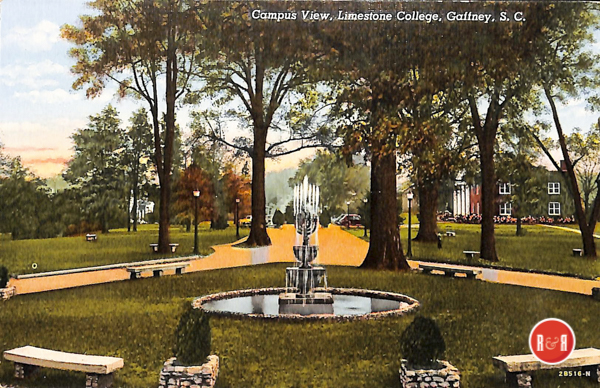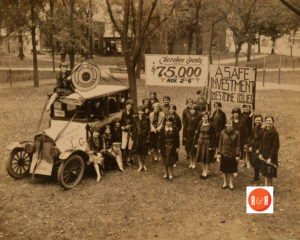The Yorkville Enquirer of July 9, 1868 reported – “The Limestone Springs Male Academy closed out its first session of the year on June 25. The principal is J. Banks Lyle who has built up a flourishing academy.”
The Yorkville Enquirer of Jan. 6, 1870 contained an ad for the – “Male school at Limestone Springs, S.C. with J. Banks Lyle a graduate of the S.C. College as Principal. The eleventh annual session will commence of Feb. 14.”
The Yorkville Enquirer reported on Sept. 7, 1871 – “A destructive storm struck near Limestone Springs in what is today Cherokee County. The route began in Union County at the home of Mr. Obediah Tate, about six miles from Limestone Springs. It then moved north to the homes of Isaack Peeler, Magnus Coyle, Pinckney Cole, and Samuel S. Ross. The storm destroyed the homes of the Coyle and Cole families.”
The Yorkville Enquirer reported on Jan. 30, 1873 – “The Limestone Springs property has recently been sold by Dr. Wm. Curtise to investors from Spartanburg. The new owners plan to develop the lime and marble resources. The new Airline railroad is within a mile of the quarries. The owners also contemplate starting a female high school in the old seminary building.”
The Yorkville Enquirer reported on May 4, 1887 – “Wyatt Harris, colored, was killed at Limestone Springs last Friday. He has been working in the lime quarries for many years. When a blast was made, he went under a shelter for protection but a heavy rock was thrown into the air and struck him.”
City Directories and History: This building reportedly was started in 1835 as a resort hotel and a new wing added in 1899. Click on the Limestone Springs Historic District to access additional data.
“Limestone Springs Academy — Gaffney—In 1845, Dr. Thomas Curtis, a Baptist minister from England, and his son bought the Limestone Springs Hotel and established a girls’ academy rivaling in fame as a girls’ school the famous Waddell school for boys. After 1865 the property was donated by Peter Cooper to the Spartanburg Baptist Association and was continued as a woman’s college. It is now the present Limestone College.”

Lovely postcard image of the Limestone Campus. Courtesy of the AFLLC Collection – 2017
Information from: Names in South Carolina by C.H. Neuffer, Published by the S.C. Dept. of English, USC
In the early nineteenth century the Limestone Springs were known as Nesbitt’s springs. Wilson Nesbitt, the owner of the springs, was operating a limestone quarry and kiln near the springs by 1820. Nesbitt was an iron manufacturer and limestone was used in the smelting of iron ore. In 1837 the Limestone Springs Company purchased 300 acres containing the line kiln and springs from Nesbitt and built a four-story, brick hotel. The relatively cool climate was believed to be healthy and waters from the Limestone Springs were said to restore strength and appetite. According to an 1841 advertisement guests would find ” ‘Baths, cold, warm, and shower, always ready at a moments notice. 1 ” Dances held in the hotel and races at a nearby track appealed to those seeking recreation as well as health. For a time the hotel enjoyed a brisk trade, attracting many lowcountry visitors, but the company was not able to make a profit on its investment and the hotel was closed around 1844. In 1845 Thomas Curtis, a native of England and a scholar and Baptist minister, and his son William Curtis, also a Baptist minister, purchased the Limestone Springs property. In 1845 the Curtises opened the Limestone Springs Female High School in the hotel building. The school was nonsectarian and in the most advanced department, courses included philosophy, theology, algebra, geometry and higher mathematics, chemistry, geology, astronomy, English poetry and composition, French, and Classical studies. The popularity of the school grew, and by 1859 there was an enrollment of 151, including students from North Carolina, Georgia, Florida, Louisiana, Tennessee, Alabama, and Mississippi as well as South Carolina. In addition to administering the school, the Curtises founded the Limestone Springs Baptist Church and began a business in the quarrying, burning, and sale of limestone, which was sold to builders, contractors, and merchants. After the death of Thomas Curtis in 1859, his son continued to operate the school. During the Civil War and Reconstruction the school experienced financial difficulties and in 1871 Curtis was forced to sell the property.
Yorkville Enquirer, Wednesday, October 1, 1862
Reserves called out (men between 35 and 50)
The Adj. Gen. Called out the 1st Reserves of SC (men between 35 and 50) for a review. York District was divided between the 6th and 7th Regiments. 6th Regiment (Col. Secrest) made up of York, Chester, and Fairfield and must report to Chester CH on October 7th. The 7th (Col. Wilson) from York, Union and Spartanburg reported to Gaffney’s Old Field near Limestone Springs on October 7th.
The Rock Hill Herald on Nov. 18, 1880 reported – “Ownership of the property of the Limestone Seminary has been transferred to the Baptist Association of Spartanburg Co. The property is now being put in order and the school will be opened as soon as repairs are made.”
During the 1870s attempts by new owners to revive the school were only moderately successful. In 1877 the current owners, Thomas H. Bomar and Charles Petty, persuaded Peter Cooper, a New York philanthropist and founder of Cooper Union, to lend financial support to the school. In return Cooper took a mortgage on the property. It was believed that the sale of lime from the quarry could result in large revenues for the school and Cooper provided loans to make improvements in the burning of lime, to build a tram railroad to carry lime to the main railway, and to purchase machinery to make barrels in which to ship the lime. Cooper’s plan of establishing a school similar to Cooper Union on the campus failed to materialize and in 1880 he donated his share of the Limestone High School property to the Spartanburg Baptist Association to be used for educational purposes and canceled the mortgage. The association purchased the remaining interest in the property from Bomar and in 1881 the school reopened as the Cooper-Limestone Institute for Young Ladies. In 1898 the name was changed to Limestone College. In 1883 in order to pay debts the Cooper-Limestone Institute sold the property containing the quarry and kilns to W.H.H. Richardson, who expanded the line manufacturing operations. Lime production at Limestone Springs under various owners continued through the late nineteenth century. Lime shipped from Limestone Springs was sold for agricultural purposes and for building products. (Information provided the NR Nomination form – S.C. Dept. of Archives and History)
The Yorkville Enquirer reported on June 27, 1888 – “The city of Gaffney is a nucleus of education and three separate school are listed and described: The Limestone Springs Female Seminary, located in a suburban area, it has spacious grounds, a grandly shaded lawn, and health giving waters. Prof. Griffith is the leader. Also the Seminary in the town limits of which Prof. Dargon and Prof. Surratt preside. The third is the Gaffney City Male and Female Seminary under the leadership of W.S. McArthur, R.O. Sams, and J.M. Tinkersley. This school was founded by Mr. McArthur eleven years ago. There is a recent two story building of brick.”
The Rock Hill Herald on Aug. 7, 1941 reported – “The building program launched in March at Limestone College in Gaffney is nearing completion. It includes a student lodge, a three story dorm, college apartments, larger dining room and kitchen, and other improvements to buildings. The college now has a total of 15 buildings.”

Sloan – Epton’s Spartanburg Co Map ca. 1869. Courtesy of the Cobb Collection – Other Side of the River Museum, 2016
Stay Connected
Explore history, houses, and stories across S.C. Your membership provides you with updates on regional topics, information on historic research, preservation, and monthly feature articles. But remember R&R wants to hear from you and assist in preserving your own family genealogy and memorabilia.
Visit the Southern Queries – Forum to receive assistance in answering questions, discuss genealogy, and enjoy exploring preservation topics with other members. Also listed are several history and genealogical researchers for hire.
User comments welcome — post at the bottom of this page.
Please enjoy his structure and all those listed in Roots and Recall. But remember each is private property. So view them from a distance or from a public area such as the sidewalk or public road.
Do you have information to share and preserve? Family, school, church, or other older photos and stories are welcome. Send them digitally through the “Share Your Story” link, so they too might be posted on Roots and Recall.
Thanks!
IMAGE GALLERY






